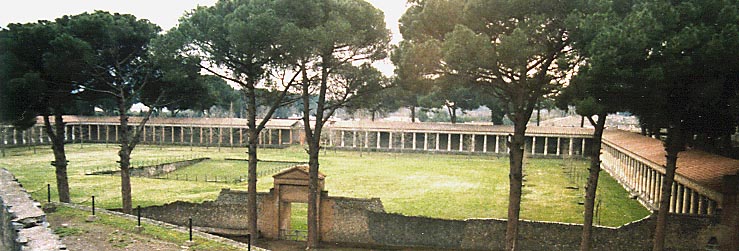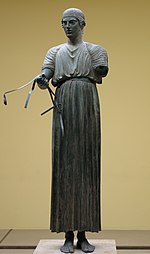Gymnasium (ancient Greece)
In Ancient Greece the Gymnasion (or Gymnasium, romanized name) was a place where athletes could train for the competitions in public games, such as the Olympic Games. Gymnos means naked. Only men were allowed to enter, and train; they did so fully naked (as the name implies). Athletes also competed in the nude. This was said to encourage aesthetic appreciation of the male body. It was believed to be a tribute to the Gods. Gymnasia and palestrae were under the protection and patronage of Heracles, Hermes and, in Athens, Theseus.[1]
Layout[change | change source]

The picture above shows the Pompeii gymnasium from the top of the stadium wall. The depression in the center-left of the picture was filled with water and used for swimming practice as well. Mock sea battles (naumachiae) took place in the flooded arena floor or a specially dug pool in the arena. According to Oscar Brockett in his History of the Theatre, 5th Ed. (1987), p. 70,
"Perhaps the most spectacular of all entertainments were the naumachiae, or sea battles. The first was given in 46 B.C. by Julius Caesar on a lake dug for the occasion; it featured a battle involving 2,000 marines and 6,000 oarsmen. Later the amphitheatres were sometimes flooded for such events. By far the most ambitious of all the naumachiae was given in 52 A.D. on the Fucine Lake east of Rome to celebrate the completion of a water conduit. On that occasion, 19,000 participants fought and many died.
To the right of the picture (partially behind a tree trunk) is a line of carbonized tree stumps. These are the remains of trees (each hundreds of years old) that were part of the palaistra. They were burned in the volcanic eruption of 79. Between these and the colonnade is a line of saplings recently planted as a replacement.
References[change | change source]
- ↑ Pausanias (geographer), Guide to Greece, 4.32.1

